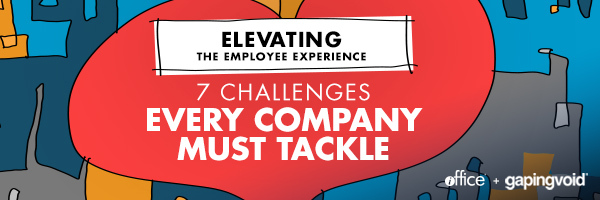The Outdated Workplace Rules Stifling the Employee Experience


The concept of the employee experience is still relatively new, though it’s quickly picking up steam. As a result, employers are making major shifts in the way their businesses run to accommodate changing employee expectations.
Sometimes it can feel as if you’re trying to fit a square peg in a round hole. But if you know which elements of the workplace are the most in need of change, you’ll be better prepared to build a company that supports and elevates the employee experience.
Here are four of the most common old-school workplace rules preventing you from creating a positive employee experience.
Outdated Rule 1
Employee self-service is viewed as a technology platform that makes it easy to complete HR transactions and generate reports.
Updated Rule
The employee experience platform is developed with design thinking principles, is mobile, and includes digital workplace apps, prescriptive solutions based on employee journeys and ongoing communications that support and inspire the workforce.
Why You Need to Embrace the Updated Rule
Employees expect their experience inside the office to mirror their life outside the office. This means using technology that promotes flexibility, mobility and connectivity. Employee experience platforms should be people-centric, not process-centric.
Outdated Rule 2
The employee experience is defined by annual engagement surveys.
Updated Rule
The employee experience is defined as a holistic view of life at work and requires constant feedback, action and monitoring.
Why You Need to Embrace the Updated Rule
Annual engagement surveys capture one single moment in an employee’s experience at the company. And because an employee’s experience changes daily, it’s simply a bad idea to make any major changes to the organization based on how they feel on one particular day each year.
Your employees don’t want to feel like a cog in the wheel; they want to know their company cares about them and is invested in their success. Checking in once a year feels more perfunctory than thoughtful.
Outdated Rule 3
Company culture is a topic on the company website (and perhaps written on the wall) but isn’t measured or defined through behavior.
Updated Rule
Companies use tools and behaviors to measure, align and improve culture during change, mergers and acquisitions, and other major initiatives.
Why You Need to Embrace the Updated Rule
Your organization’s dedication to the company culture (or lack thereof) is representative of its dedication to the workforce. Your company culture is your brand identity. And if the business doesn’t appear to be invested in how the business is perceived by employees or the community (especially during major changes like a merger or acquisition), it shows a lack of commitment to the future of the company.
Each aspect of your business should reflect your culture, and each member of your workforce should understand his or her role in and influence on the culture.
Outdated Rule 4
Wellness and health programs are focused on safety and managing insurance costs.
Updated Rule
Companies have an integrated program for employee well-being, which is focused on the employee, her family, and her entire experience both in personal life and professional life.
Why You Need to Embrace the Updated Rule
While it’s true employee wellness programs can benefit a company’s bottom line, that shouldn’t be the only reason the business encourages employees to take care of themselves. Happy, healthy employees will be more inclined to stick around at a company that cares about their happiness and health. And the more her employer demonstrates its investment in her wellbeing, the more dedicated the employee will be to the wellbeing of the company.
It may seem daunting to revise policies and procedures that have been in place for years (if not decades). But when you make these changes, you’ll be creating a better work environment and a more engaged and satisfied workforce. And the higher the engagement and satisfaction, the higher the retention.
